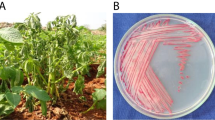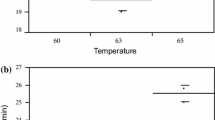Abstract
Bacterial wilt of sweet potato is caused by Ralstonia solanacearum, which is distributed in southern China and causes significant economic losses each year. The pathogen is soil- and rhizome-borne, and thus its rapid detection may prevent the occurrence and spread of the disease. R. solanacearum has been listed as a quarantine disease in China. With the advent of molecular biology, many novel tools have been explored for the rapid identification of plant pathogens. In this study, a strain-specific detection method was developed for this specific pathogen that infects sweet potato using loop-mediated isothermal amplification (LAMP). A set of new LAMP-specific primers was designed from the orf428 gene, which can specifically detect the R. solanacearum bacterium that infect sweet potato. The LAMP reaction consisted of 8.0 mmol·L−1Mg2+, 1.4 mmol·L−1 dNTPs, and 0.32U μL−1 Bst 2.0 DNA polymerase and was performed at 65 °C for 1 h. The amplification products were detected by visualizing a mixture of color changes using SYBR Green I dye and assessing ladder-like bands by electrophoresis. Our method has specificity, i.e., it only detected R. solanacearum in sweet potato, and it has high sensitivity, with a detection limit of 100 fg·μL−1 genomic DNA and 103 CFU·mL−1 of bacterial fluid. In addition, R. solanacearum could be directly detected in infected sweet potato tissues without the need for DNA extraction. The LAMP method established in this study is a highly specific, sensitive, and rapid tool for the detection of bacterial wilt in sweet potato caused by R. solanacearum.






Similar content being viewed by others
References
Bonizzoni M, Afrane Y, Yan GYJAJOTM (2009) Loop-mediated isothermal amplification (LAMP) for rapid identification of Anopheles gambiae and Anopheles arabiensis mosquitoes. Am J Trop Med Hyg 81:1030
Boubourakas IN, Fukuta S, Kyriakopoulou PEJJOVM (2009) Sensitive and rapid detection of peach latent mosaic viroid by the reverse transcription loop-mediated isothermal amplification. J Virol Methods 160:63–68
Chandra A, Keizerweerd AT, Que Y, Grisham MP (2015) Loop-mediated isothermal amplification (LAMP) based detection of Colletotrichum falcatum causing red rot in sugarcane. Mol Biol Rep 42:1309–1316
Chen Y, Lin Y, Chung W (2011) Creeping stem cuttings, the possible inoculum source for bacterial wilt of vegetable sweetpotato. Phytopathology 101:34
Chen Y-J, Lin Y-S, Chung W-H (2012) Bacterial wilt of sweet potato caused by Ralstonia solanacearum in Taiwan. J Gen Plant Pathol 78:80–84
Chen Y-J, Lin Y-S, Tseng K-J, Chung W-H (2014) Vine cuttings as possible initial inoculum sources of Ralstonia solanacearum race 1 biovar 4 on vegetable sweet potato in fields. Eur J Plant Pathol 140:83–95
Cheng TY, Liu GHJAP (2017) PCR denaturing gradient gel electrophoresis as a useful method to identify of intestinal bacteria flora in Haemaphysalis flava ticks. Acta Parasitologica 62:269–272
Clark C, Davis J, Abad J, Cuellar W, Fuentes S, Kreuze J, Rw G, Mukasa S, Tugume A, Tairo F, Jpt V (2012) Sweetpotato viruses: 15 years of progress on understanding and managing complex diseases. Plant Dis 96:168–185
Clark CA, Moyer JW (1988) Compendium of sweet potato diseases. Mycologia 81:175
Clark CA, Wilder-Ayers JA, Duarte V (1989) Resistance of sweet potato to bacterial root and stem rot caused by Erwinia chrysanthemi. Plant Dis 73:984–987
Clark CA, Dukes PD, Moyer JW (1992) Fifty years of cooperative sweetpotato research. Southern Coop Ser Bull 369:88–105
Ding S-W, Yang S-H, Wu W-J, Xie H, Xu C-L (2019) Rapid diagnosis of Ditylenchus destructor by loop-mediated isothermal amplification assay based on 28S rRNA sequences. Eur J Plant Pathol 153:1165–1175
Douda O, Marek M, Zouhar M, Ryšánek PJPM (2013) Insights into the structure and phylogeny of the 28S rRNA expansion segments D2 and D3 of the plant-infecting nematodes from the genus Ditylenchus (Nematoda: Anguinidae). Phytopathologia Mediterranea 52:84–97
Du L, Shi W, Li X, Lan Y, Sun F, Fan Y, Zhou T, Zhou Y (2019) A reverse-transcription loop-mediated isothermal amplification (RT-LAMP) assay for detecting the pathogen of maize rough dwarf disease in China. Australas Plant Pathol 48:485–489
Duan Y, Ge C, Zhang X, Wang J, Zhou M (2014) A rapid detection method for the plant pathogen Sclerotinia sclerotiorum based on loop-mediated isothermal amplification (LAMP). Australas Plant Pathol 43:61–66
Eshraghi L, Aryamanesh N, Anderson JP, Shearer B, McComb JA, Hardy GESJ, O’Brien PA (2011) A quantitative PCR assay for accurate in planta quantification of the necrotrophic pathogen Phytophthora cinnamomi. Eur J Plant Pathol 131:419
Fegan M, Prior P (2005) How complex is the Ralstonia Solanacearum species complex. Bact Wilt Dis Ralstonia Solanacearum Species Complex. APS, St. Paul, pp 449–462
Fernández-Álvarez C, González SF, Santos Y (2016) Development of a SYBR green I real-time PCR assay for specific identification of the fish pathogen Aeromonas salmonicida subspecies salmonicida. Appl Microbiol Biotechnol 100:10585–10595
Fukuta S, Takahashi R, Kuroyanagi S, Miyake N, Nagai H, Suzuki H, Hashizume F, Tsuji T, Taguchi H, Watanabe H, Kageyama K (2013) Detection of Pythium aphanidermatum in tomato using loop-mediated isothermal amplification (LAMP) with species-specific primers. Eur J Plant Pathol 136:689–701
Goto M, Honda EA, Nomoto A, Hanaki KJB (2009) Colorimetric detection of loop-mediated isothermal amplification reaction by using hydroxy naphthol blue. Biotechniques 46:167–172
Hayward AC (1991) Biology and epidemiology of bacterial wilt caused by Pseudomonas Solanacearum. Annu Rev Phytopathol 29:65–87
He L, Sequerira L, Kelman A (1983) Characteristics of strains of Pseudomonas solanacearum from China. Plant Dis 67:1357–1361
Huang L, Chen YX, Huang, HY (1956) A preliminary report on the control of sweet potato blast. Acta Phytopathologica Sinica 2:210–211 (in chinese)
Huang LF, Fang BP, Luo ZX, Chen JY, Zhang XJ, Wang ZY (2010) First report of bacterial stem and root rot of sweetpotato caused by a Dickeya sp (Erwinia chrysanthemi) in China. Plant Dis 94:1503
Huang W, Zhang H, Xu J, Wang S, Kong X, Ding W, Xu J, Feng JJFPS (2017) Loop-mediated isothermal amplification method for the rapid detection of Ralstonia solanacearum phylotype I mulberry strains in China. Front Plant Sci 8:76
Imai M, Ai N, Minekawa H, Notomi T, Ishizaki T, Tashiro M, Odagiri TJV (2006) Development of H5-RT-LAMP (loop-mediated isothermal amplification) system for rapid diagnosis of H5 avian influenza virus infection. Vaccine 24:6679–6682
Jiang G, Wei Z, Xu J, Chen H, Zhang Y, She X, Macho AP, Ding W, Liao B (2017) Bacterial wilt in China: history, current status, and future perspectives. Front Plant Sci 8:1–10
Kubota R (2012) Engineering a simple, rapid, inexpensive, nucleic acid based system for strain selective detection of the bacterial wilt pathogen Ralstonia solanacearum. Ph.D. University of Hawaii at Manoa
Kubota R, Vine BG, Alvarez AM, Jenkins DMJP (2008) Detection of Ralstonia solanacearum by loop-mediated isothermal amplification. Phytopathology 98:1045
Le Floch G, Tambong J, Vallance J, Tirilly Y, Lévesque A, Rey P (2007) Rhizosphere persistence of three Pythium oligandrum strains in tomato soilless culture assessed by DNA macroarray and real-time PCR. FEMS Microbiol Ecol 61:317–326
Maeda H, Kokeguchi S, Fujimoto C, Tanimoto I, Yoshizumi W, Nishimura F, Takashiba S (2005) Detection of periodontal pathogen Porphyromonas gingivalis by loop-mediated isothermal amplification method. FEMS Immunol Med Microbiol 43:233–239
Nagamine K, Hase T, Notomi TJMCP (2002) Accelerated reaction by loop-mediated isothermal amplification using loop primers. Mol Cell Probes 16:223–229
Nair S, Manimekalai R, Ganga RP, Hegde VJWJOM (2016) Loop mediated isothermal amplification (LAMP) assay for detection of coconut root wilt disease and arecanut yellow leaf disease phytoplasma. World J Microbiol Biotechnol 32:108
Niu JH, Jian H, Guo QX, Chen CL, Guo YDJPP (2012) Evaluation of loop-mediated isothermal amplification (LAMP) assays based on 5S rDNA-GS2 regions for detecting Meloidogyne enterolobii. Plant Pathol 61:809–819
Notomi T, Okayama H, Masubuchi H, Yonekawa T, Watanabe K, Amino N, Hase T (2000) Loop-mediated isothermal amplification of DNA. Nucleic Acids Res 28:e63
Pastrik KH, Elphinstone JG, Pukall R (2002) Sequence analysis and detection of Ralstonia solanacearum by multiplex PCR amplification of 16S–23S ribosomal intergenic spacer region with internal positive control. Eur J Plant Pathol 108:831–842
Peng D, Xie J, Qiang W, Ling KS, Zhou T (2017) One-step reverse transcription loop-mediated isothermal amplification assay for detection of Apple chlorotic leaf spot virus. J Virol Methods 248:154–158
Sunani SK, Bashyal BM, Rawat K, Manjunatha C, Sharma S, Prakash G, Krishnan SG, Singh AK, Aggarwal R (2019) Development of PCR and loop mediated isothermal amplification assay for the detection of bakanae pathogen Fusarium fujikuroi. Eur J Plant Pathol 154:715–725
Tan HM, Cao LX, He ZF, Su GJ, Lin B, Zhou SNJWJOM (2006) Isolation of endophytic actinomycetes from different cultivars of tomato and their activities against Ralstonia solanacearum in vitro. World J Microbiol Biotechnol 22:1275–1280
Thangavelu R, Devi PGJB (2018) Rapid and sensitive detection of Pseudocercospora eumusae pathogen causing eumusae leaf spot disease of banana by loop-mediated isothermal amplification (LAMP) method. 3 Biotech 8:442
Tomlinson J, Boonham N, Hughes KJD, Griffen RL, Barker I (2005) On-site DNA extraction and real-time PCR for detection of Phytophthora ramorum in the field. Appl Environ Microbiol 71:6702–6710
Wang Z, Gu Q, Sun H, Li H, Sun B, Liang X, Yuan Y, Liu R, Shi YJJOVM (2014) One-step reverse transcription loop mediated isothermal amplification assay for sensitive and rapid detection of Cucurbit chlorotic yellows virus. J Virol Methods 195:63–66
Wei W, Miaohong R, Qiu YX, Wang WY, Ke YQ, Pan TG (2009) Phenylaprapanoid metabolism of sweet potato against Pseudomonas solanacearum. Chin J Eco-Agric 17:944–948
Acknowledgements
This work was supported by the following grants: China Agriculture Research System (CARS-10-B14); Program of Seed Industry Innovation and Industrialization of Fujian Province (fjzycxny2017005); Program of Innovative Research Team of Fujian Academy of Agricultural Sciences (STIT2017-2-3).
Author information
Authors and Affiliations
Corresponding author
Ethics declarations
Conflict of interest
The authors declare no competing interests.
Additional information
Communicated by Erko Stackebrandt.
Publisher's Note
Springer Nature remains neutral with regard to jurisdictional claims in published maps and institutional affiliations.
Rights and permissions
About this article
Cite this article
Li, H., Zhang, H., Liu, Z. et al. Rapid diagnosis of Ralstonia solanacearum infection sweet potato in China by loop-mediated isothermal amplification. Arch Microbiol 203, 777–785 (2021). https://doi.org/10.1007/s00203-020-02059-8
Received:
Revised:
Accepted:
Published:
Issue Date:
DOI: https://doi.org/10.1007/s00203-020-02059-8




